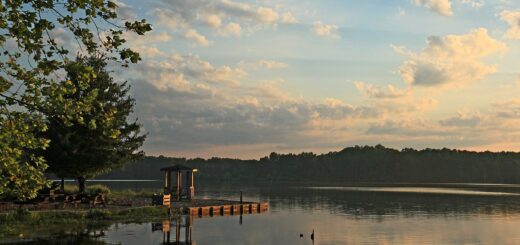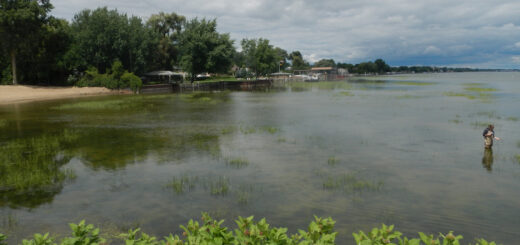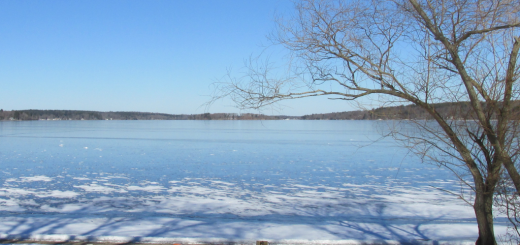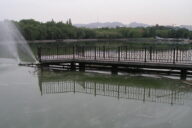Research Brief: 20-Year Phytoplankton Biomass Trends in Lake Erie
0Climate change-induced changes to the Great Lakes regions have led to resurgent eutrophication in Lake Erie’s western basin. This eutrophication is characterized by the ever-familiar algal blooms that dominate the region. Despite consistent monitoring efforts, there is limited research on the effects of eutrophication and of the blooms themselves on the rest of the phytoplankton community.
Over time, blooms have increased in frequency and severity, likely as a result of agricultural runoff, which is exacerbated by climate change-driven increases in precipitation and intensive agriculture practices. As a result, algal monitoring is common in Lake Erie, but there are still knowledge gaps.
A 2023 study published in the Journal of Great Lakes Research examined temporal patterns in phytoplankton community structure as well as the biomass of six key phytoplankton groups from 1995 in the western basin or 2000 in the central basin to 2015 for both.1
The goal of the study was to answer the following questions:
- “How has phytoplankton community structure changed over the period of record in the WB and CB?
- How has the biomass of six key phytoplankton taxonomic groups changed over the period of record within these three seasons?
- What impact have these changes had on the relative biomasses and seasonal patterns of edible and less-edible algal taxa?”1
Based on previous observations, the researchers hypothesized that an increase in cyanobacterial biomass in both basins would correspond to clear declines in the absolute biomass of other phytoplankton taxa due to resource competition.
Methods
The analysis was conducted using the existing 20-year Lake Erie Plankton Abundance Study (LEPAS) dataset, which allowed them to quantify intra- and interannual trends in the dynamics of six major phytoplankton groups in the western and central basin during 1995–2015. The LEPAS dataset was chosen as it observed both regions of the lake during two decades of eutrophication and climate change.
From 1995 to 2015, an integrated water sample was taken at all eight monitoring sites approximately every two weeks.
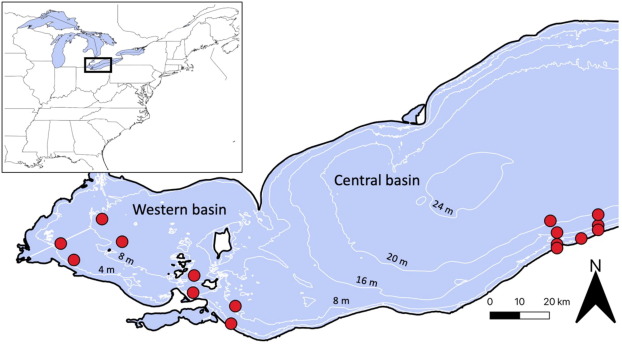
Sampling locations in the Lake Erie’s western basin (1995–2015) and central basin (2000–2015). Sampling was conducted approximately biweekly in Ohio waters of both basins from late April through early October as part of the Lake Erie Plankton Abundance Study. Depth isoclines (white lines) are shown at 4-meter intervals. (Credit: O’Donnell et al., 2023)
Results
Contrary to predictions, the LEPAS dataset revealed increases in the biomass of several non-cyanobacteria phytoplankton groups. For example, “edible phytoplankton biomass increased in the western basin and exhibited no directional change in the central basin.”1
Instead of a recourse competition occurring during Microcystis blooms (resulting in increases in Microcystis and decreases in other taxa), increases in annual nutrient loading to Lake Erie between 1995–2015 benefited both Microcystis and other taxa.1
Blooms increased in frequency over the observed period. More specifically, cyanobacteria in the western basin increased >1000-fold, and all other major taxa groups increased 10- and 100-fold. Temporally, early summer (June-July) and spring (May) phytoplankton communities saw more modest directional change in the biomass of both edible and less-edible taxa as well as community structure.
Unlike the annual Microcystis blooms in the western basin, the LEPAS dataset shows that the central basin experienced its first of many over the observed period in 2008. However, the central basin faced less severe blooms than the western basin, and as a result, impacts on the phytoplankton communities were less dramatic.
While the analysis revealed more information on the spatial and temporal dynamics of phytoplankton biomass trends in Lake Erie, the underlying mechanisms are still not well understood.
Source
- O’Donnell, D.R., Briland Ruth, Budnik R.R., Ludsin, S.A., Hood, J.M., 2023. Trends in Lake Erie phytoplankton biomass and community structure during a 20-year period of rapid environmental change. Journal of Great Lakes Research, Volume 49, Issue 3, 672-684. ISSN 0380-1330. https://doi.org/10.1016/j.jglr.2022.12.011.




